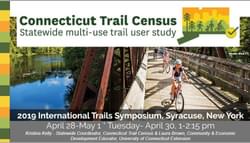Making it Count: Analyzing Trail Use Data in New York and Connecticut
Presenters outline the techniques used and lessons learned from trail counts in New York and Connecticut.
by
Laura Brown, Community & Economic Development Educator, University of Connecticut,
Dylan Carey, Project Coordinator, Parks and Trails New York,
Jennifer Ceponis, Senior Transportation Planner, Capital District Transportation Committee,
Emily Dozier, Senior Planner, Dutchess County Transportation Council,
Kristina Kelly, Statewide Coordinator, Connecticut Trail Census,
James Stevens, Senior Associate, ConsultEcon, Inc.
Presenters outline the techniques used and lessons learned from trail counts in New York and Connecticut, including discussion of evolving technology available for automated trail counts, utilizing volunteers, and scaling county protocols from local to regional to statewide. The session will also discuss using trail count data to inform planning decisions and to make estimates of trail-related economic impact.
Learning Objectives:
- Increase knowledge of available protocols and techniques that can be used for trail counts at various scales (local, regional, statewide).
- Provide best practices regarding using volunteers in trail data collection.
- Increase understanding of the use of trail counts and trail-related data to spur community engagement and communicate public health benefits of trails.

About the Authors
Laura Brown is an Associate Professor, Community & Economic Development Educator with University of Connecticut Extension and Certified Economic Developer (CEcD). Laura conducts applied research and educational programs that build community capacity and help community leaders make informed decisions. Her work focuses on asset-based community and economic development, place-making, and food systems and she is a co-founder of the Connecticut Trail Census. She has 18 years of professional community development experience in urban and rural communities around New England and the Midwest. Originally from Taunton, Massachusetts, Laura holds a M.S. in Urban and Regional Planning from University of Wisconsin, Madison and a B.S. from Clark University.

Dylan Carey is the Project Coordinator for Parks & Trails New York (PTNY), a statewide non-profit organization that works to expand, protect and promote a network of parks, trails and open spaces throughout the state. Dylan manages several components of PTNY’s work on the Erie and Champlain Canalway Trails, including the annual Canal Clean Sweep, Adopt-a-Trail and Trail Ambassador programs, Canalway Trail Count program, Bike Friendly New York business certification program, and annual Bicyclists Bring Business roundtable and bike-around. Dylan also works on trails-related advocacy and planning efforts for PTNY.
Jen Ceponis is a Senior Transportation Planner with the Capital District Transportation Committee (CDTC), the Metropolitan Planning Organization (MPO) for New York’s Capital Region. She has been with CDTC since 2008. Most recently she has been involved in promoting bicycle safety through CDTC’s bicycle safety campaign Capital Coexist, developing travel demand management programs, overseeing a number of land use and transportation integration planning studies, and managing the Capital Region’s trail count and survey program as well as the Capital District Trails Plan. Jen is also the Coordinator of Capital District Clean Communities (CDCC), a government/industry partnership through the U.S. Department of Energy’s Clean Cities program whose mission is to support local decisions to reduce the use of petroleum fuels in transportation. Jen is on the Board of Directors of Capital CarShare, a non-profit carsharing organization in Albany that she helped launch in 2014 and is the Chair of the NYS MPO Climate Change Working Group. Jen received her Bachelors degree in Sociology and Philosophy from Siena College and her Masters in Regional Planning from the State University of New York at Albany.

Emily Dozier, AICP is a Senior Planner with the Dutchess County Transportation Council (DCTC), the MPO for Dutchess County. Emily manages the DCTC’s bicycle and pedestrian program, Complete Streets efforts, and safety work. Emily is the current chair of the New York State Association of MPOs (NYSAMPO) Bicycle-Pedestrian Working Group. She holds dual Masters degrees in City and Regional Planning and Transportation Engineering from the University of California, Berkeley.
Kristina Kelly is the Statewide Coordinator for the Connecticut Trail Census. Kristina has experience coordinating volunteer data collection programs such as DEEP’s Riffle Bioassessment by Volunteers (RBV) and has developed a passion for citizen science as a way to involve the community in environmental education, protection and advocacy. She is currently pursuing a Master of Science degree in Geography with a concentration in Sustainability where she enjoys studying environmental protection, community engagement, and natural resources.
James Stevens is an economic development planner and management consultant that specializes in recreational planning and economic analysis of trails, parks, recreation facilities, and other public and private facilities. He is working with the CDTC on evaluating the economic impacts and public benefits of the regional trail plan update.
Based in Massachusetts and Pennsylvania, James is a Senior Associate at ConsultEcon, Inc., a national and international economic research and management consulting firm in Cambridge, MA. Prior he held a variety of positions in a startup company and community and economic development organizations.
James has a Master’s Degree in City Planning from the Massachusetts Institute of Technology and a Bachelor’s Degree in History from Cornell University. He is a member of the National Recreation and Park Association, the American Planning Association, and the Urban Land Institute.
More articles in this category
Benchmarking Bike Networks
posted Apr 17, 2024
This report summarizes guidance and best practices to create safer bicycle facilities and connect them into networks that allow more people to safely bike to more places within and throughout communities.
Setting Speed Limits for Health and Safety
posted Apr 17, 2024
This mini-report on setting speed limits shows the current framework for speed limit policies through a review of state laws that set speed limits.
Winter Recreation Planning
posted Nov 14, 2023
These case studies reveal a number of lessons learned that will be valuable in future winter travel management planning efforts.
TRAILS SAFE PASSING PLAN: STOP, SPEAK, and STAND BACK
posted Feb 14, 2023
Horses are prey animals and naturally can be afraid of unfamiliar people and objects. Horses have natural "flight“ survival instincts and prefer to move their feet towards an exit route. Therefore, people with horses should pass at a walk while other trail users remain STOPPED until passed.
816 views • posted 06/05/2019





